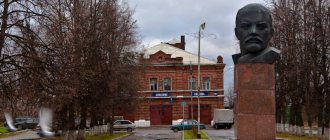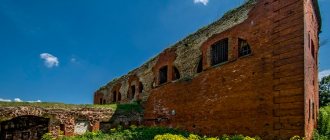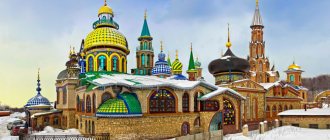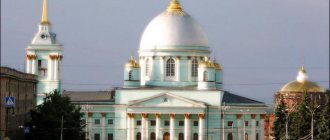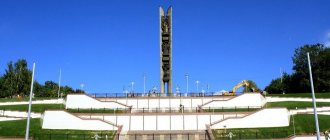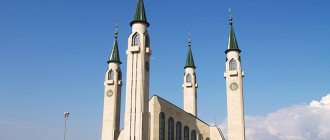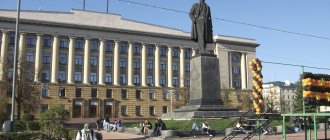Not far from St. Petersburg, on the banks of the Volkhov River there is the Staraya Ladoga fortress. This is one of the most ancient settlements in our country and, according to some historians, the first capital of Russia. Today Staraya Ladoga is formally considered only a small village. But for tourists who are interested in history, it certainly deserves a visit. In addition, almost the entire territory of Staraya Ladoga is a unique museum-reserve with preserved historical, cultural and architectural monuments of the 8th–19th centuries.
Even if you are not very interested in history and archeology, then you will like this corner of Russia with its beautiful picturesque places, where you will undoubtedly be able to feel the spirit of antiquity, relax and enjoy the beauty of nature.
How to get to Staraya Ladoga
- Staraya Ladoga is located in the lower reaches of the Volkhov River, 125 km from St. Petersburg.
- By car from St. Petersburg along the Kola highway, about 100 km. Turn to Staraya Ladoga and Myakinino.
- By train from Ladozhsky station to Volkhovstroy-1 station. Next take bus 23.
- By excursion bus from St. Petersburg
- In 2021, a pier was built in Staraya Ladoga near the Nikolsky Monastery, where ships on cruises along the rivers and lakes of Russia can stop. Most cruises depart from St. Petersburg. In addition to Staraya Ladoga, cruises include stops on the islands of Valaam and Konevets, the village of Mandrogi and others. The routes are very varied and last several days.
History of the study
XVIII century
Staraya Ladoga is considered the site of the first excavations in the history of Russian archaeology. In 1708, the pastor of the evangelical city community of St. Petersburg and the entire Russian fleet, Wilhelm Tolle, carried out the first field work here. He studied the location, topography of the city and its surroundings, archaeology, language and ethnography of the local population, as well as a herbarium of local flora (more than 300 species). During the work, corpses were discovered in urns dating back approximately to the 10th – 11th centuries, rare vessels, and coins. Finds recovered from the Ladoga burial mounds formed his collection.
Cost of tickets to the Staraya Ladoga Museum-Reserve in 2021
- Entrance to the fortress territory For adults - 50 rubles
- For children under 16 years old - free
- For children from 16 to 18 years old, students of Russian universities and pensioners - 20 rubles
- For adults - 250 rubles
- For adults - 100 rubles
According to the Tale of Bygone Years, from 862 to 864 Staraya Ladoga served as the residence of Rurik, the legendary Scandinavian prince who laid the foundation for the famous Rurik dynasty. Therefore, we can say that during these years Staraya Ladoga was the ancient capital of Northern Rus'. For the next 20 years, Rurik reigned in Veliky Novgorod.
It should be noted that monuments of an earlier age were also found in the village, so the exact date of cutting down the logs from which one of the buildings was built was established; this find dates back to 753. It is this year that is accepted as the date of the founding of Staraya Ladoga.
Two well-known trade routes passed through Staraya Ladoga - “from the Varangians to the Greeks” and “from the Varangians to the Arabs”. Here, in the second half of the 8th century, the first money appeared; its role was played by beads made using Arab technology, and the value of such a bead was very great - you could buy a slave with it.
On the banks of the Volkhov there was a brisk trade - local residents sold furs brought from Scandinavia to the Arabs for silver dirhams. This is confirmed by both individual finds and treasures discovered during excavations.
In the Middle Ages, Staraya Ladoga served as an outpost of Russian lands, repelling the ferocious attacks of its northern neighbors. The first fortress was wooden; at the end of the 9th - beginning of the 10th century, the Varangians laid out a fortress wall with towers made of local limestone. The constructed settlement became the first stone fortress on the territory of Ancient Rus'.
With the founding of St. Petersburg in 1703, Staraya Ladoga found itself far from the border and lost its defensive significance. Historically, no major construction took place in the village, and to this day a cultural surface layer 2–5 meters deep, filled with archaeological finds, has been preserved here.
It is interesting that before Peter the Great the settlement was called Ladoga. In 1702, on the instructions of the emperor, not far from Staraya Ladoga, at the mouth of the Volkhov River, a shipbuilding shipyard was created, for which shipbuilders were resettled from the Russian North. In 1704, Peter founded the city of Novaya Ladoga here, and the former settlement began to be called Staraya Ladoga.
In 2003, the 1250th anniversary of Staraya Ladoga, the ancient capital of the Russian state, was solemnly celebrated.
In Staraya Ladoga you will explore historical, cultural and architectural monuments. The territory of the village is unique - in its entire history, only two percent of it has been excavated. While in Staraya Ladoga, you will walk through a layer of earth in which finds of wood and glass, bronze and iron, leather and fabric have been preserved.
The main attraction of Ladoga is the fortress, built in the place where the Ladozhka River flows into the Volkhov River. The fortification was of great importance for protecting the waterway from the Baltic Sea deep into Novgorod Rus'.
Currently, we will see only the fortress built here in the 16th century, although fragments of an earlier structure have also been preserved. The thickness of the fortress walls reaches 7 meters, and the height of the towers is 12 meters.
On the territory of the fortress there is a 12th-century St. George’s Church. Often this snow-white temple, crowned with only one dome, is called the Ladoga Bride. The church preserves a very unusual fresco dedicated to St. George. Most often, the Saint is depicted with a spear killing a serpent, but here he holds the banner of victory in his hand, and the pacified dragon allows the princess to behave on a leash.
Nikolsky Monastery was founded in honor of the victory of the Russian army over the Swedish in 1240. On the territory of the current monastery there is the Church of St. John Chrysostom of the second half of the 19th century with picturesque frescoes, as well as the St. Nicholas Church and the bell tower.
Be sure to walk along Varyazhskaya Street, famous for the fact that it was in this place that objects from the 9th–10th centuries were found. On Varyazhskaya Street you will see the symbol of the village - a small sculpture of a falcon made of bronze. There is also a chapel of the early 20th century and two museums - the Museum of Merchant Life and the Museum of Archeology of Ladoga.
The Staraya Ladoga Assumption Monastery was founded in 1156, and was first mentioned in the 15th century. Initially it was a men's monastery, later converted into a women's monastery. The monastery became a place of imprisonment for many famous women. So, in 1718, Evdokia Lopukhina, the first wife of Peter the Great, was brought here, and in the 19th century, relatives of the Decembrists were kept here. The main attraction of the monastery is the Assumption Cathedral, built in the 12th century - in the pre-Mongol period.
The Church of the Nativity of John the Baptist is located in the place where the St. John the Baptist Monastery was previously located. The temple stands out with its green domes; it seems to float between the earth and the sky. In the Church of the Nativity of John the Baptist, ancient frescoes have been preserved.
One of the attractions of Staraya Ladoga is Oleg’s grave, which is a large mound. According to legend, it was in Staraya Ladoga that the ancient Russian prince Oleg was buried. According to the Kyiv version, Prophetic Oleg is buried in Kyiv on Mount Shchekovitsa. Both legends say that the cause of the prince’s death was a snake bite.
According to legend, the Magi predicted the prince's death from his horse. Then Oleg ordered the animal to be taken away. A few years later, when the horse had already died, the prince came to his grave and grinned, remembering the prediction of the Magi. At that moment, a snake crawled out of the horse’s skull and bit Oleg.
In addition, there are caves in Staraya Ladoga, the largest of which is Tanechkina. Its length is more than 7 km. In one of its branches there is a lake 0.5 meters deep. Tanechkina Cave is also known for the fact that it is home to a huge flock of bats numbering more than 400 individuals.
1970s
Systematic study of the monument was resumed in the 1970s by a whole galaxy of Leningrad scientists. Over the years, O. I. Aleksandrovsky, A. L. Davidan, N. V. Grigorieva, G. P. Grozdilov, S. N. Orlov, N. A. Krenke, V. S. Nefedov, E. A. Ryabinin, V. P. Petrenko and others.
At that time, the interpretation of Ladoga antiquities as authentically Slavic was met with general distrust, and an exaggerated role began to be assigned to all sorts of foreign ethnic components. Some researchers (G.F. Korzukhina, D.A. Avdusin) were inclined to consider Ladoga more of a Finnish territory. Doubts and contradictions in the interpretation of Ladoga materials prompted the Leningrad branch of the Institute of Archeology of the USSR Academy of Sciences (LOIA) to re-create the Staraya Ladoga archaeological expedition in 1972. Thus, a new cycle of exploration of the territory began.
Since 1972, the Staraya Ladoga expedition was led by Anatoly Nikolaevich Kirpichnikov, head of the Department of Slavic-Finnish archeology of the Institute of Historical and Cultural History of the Russian Academy of Sciences. He examined the fortifications of the stone fortress, identifying on its territory the remains of three fortifications that succeeded each other throughout the Middle Ages. By the beginning of the 1980s, all the assigned tasks were completed. In particular, the stratigraphy and chronology of Zemlyanoy Gorodische and Ladoga Posad were clarified.
Remains of production (unfinished products, drops of glass, brass blanks, crucibles, dolls, molds, sawn bone, some specialized tools, etc.), identified in Ladoga houses of the 8th - 10th centuries with numerous household products, suggested that in these houses At the same time, general craftsmen, masters of metal, bone, amber, etc. lived and worked. The largest discovery was the discovery of the oldest jewelry, metalworking and foundry workshop in early medieval Europe, dating back to the 750s, with a “treasure” of 28 tools. No less important was the study of the oldest glass-making workshop in Rus', which worked on recycled materials (broken glass) in the first decades of the 9th century. Thanks to new research, the city in the lower reaches of the Volkhov began to be viewed in the context of broad trade and cultural ties. This approach turned out to be fruitful and put an end to the peculiar scientific isolation of Ladoga as an exclusively local, closed phenomenon.
Anatoly Nikolaevich Kirpichnikov Soviet and Russian archaeologist, Doctor of Historical Sciences, Honored Scientist of the RSFSR (1991), Honorary Citizen of the Leningrad Region (2013), Member of the Scientific Council of the Russian Military Historical Society Photo source
Architectural monuments
There are many architectural monuments in the village that the villagers take care of. It is impossible to tell about everyone. We present some of them.
Barracks of the Suzdal Regiment
The second half of the 18th century was marked by numerous peasant riots. Staraya Ladoga did not escape the same fate. To pacify the rebels, the Suzdal Infantry Regiment, commanded by Suvorov, was transferred.
The barracks appeared at the beginning of the 18th century, when Peter the Great ordered the construction of a canal here to bypass Lake Ladoga during storms. Workers lived in the buildings
At first the soldiers were housed in private houses. Controlling a scattered army was difficult.
Suvorov initiated the construction of barracks with all the necessary buildings.
In addition to the premises for soldiers, on the same territory there are:
- stable;
- infirmary;
- officers' club;
- parade ground with a shooting range;
- wooden temple.
Currently, the barracks are dilapidated, but a memorial plaque in which Suvorov is noted is on the wall.
Take note: the monument to the Barracks of the Suzdal Regiment is located on Proletarsky Kanal Street, building 12.
If a tourist arrives by bus, it will take a quarter of an hour to reach the barracks. You need to go towards the exit from the village, cross the canal and turn left. The ancient monument will be on the right.
Gostiny Dvor building
There is no exact date for the construction of Gostiny Dvor, but historians suggest that it was built in the 19th century. Going inside, you can see a quadrangular square. Along the walls there are benches where merchants once sat.
It has a standard layout, typical for buildings of this type: a quadrangle with an area inside, along the perimeter of which there are merchant shops, separated from the street by an arcade. The building was probably built in the 19th century
The house is located in Novaya Ladoga, 11 kilometers from Staraya. Between Karl Marx Avenue and Pionerskaya Street.
Some results of excavations to date
- About 100 remains of residential, industrial and utility buildings were discovered. This allowed scientists to re-imagine house-building, including the construction of huts, five-walled houses, religious and other buildings.
- The oldest jewelry, metalworking and foundry workshop in early medieval Europe dating back to the 750s, with a large set of tools and rare, highly artistic decorations of Scandinavian costumes for men and women, was discovered.
- Residential and industrial parcels of standard width have been identified. This helped reimagine the beginnings of regularly planned development in European cities.
- A scale of the evolution of urban tableware has been compiled, indicating the increasingly clear introduction of the potter's wheel after 900.
- Stage-by-stage structures of ancient Russian stone and wood-earth fortification have been discovered, which until the end of the 15th century ensured the safety of citizens and the protection of the northern borders of the country.
- A map has been compiled that reflects at least 160 monuments of Ladoga archaeology, architecture and history. It became known how the territory of the city and the surrounding burial grounds developed. For the first time, the plan of a medieval city with its districts - “ends” and monumental buildings - has been reconstructed.
- After 10 years of efforts by the expedition and the Leningrad regional branch of the All-Russian Society for the Protection of Historical and Cultural Monuments, in 1984 a government decision was made to create the Staraya Ladoga Historical, Architectural and Archaeological Museum-Reserve. This prevented the destruction of a number of historical sites, including the cultural layer of the ancient city. The territory of the village, measuring about 200 hectares, with its architectural and archaeological monuments, buildings of the 19th – early 20th centuries, and the cultural layer of the Middle Ages, has been taken under special protection.

